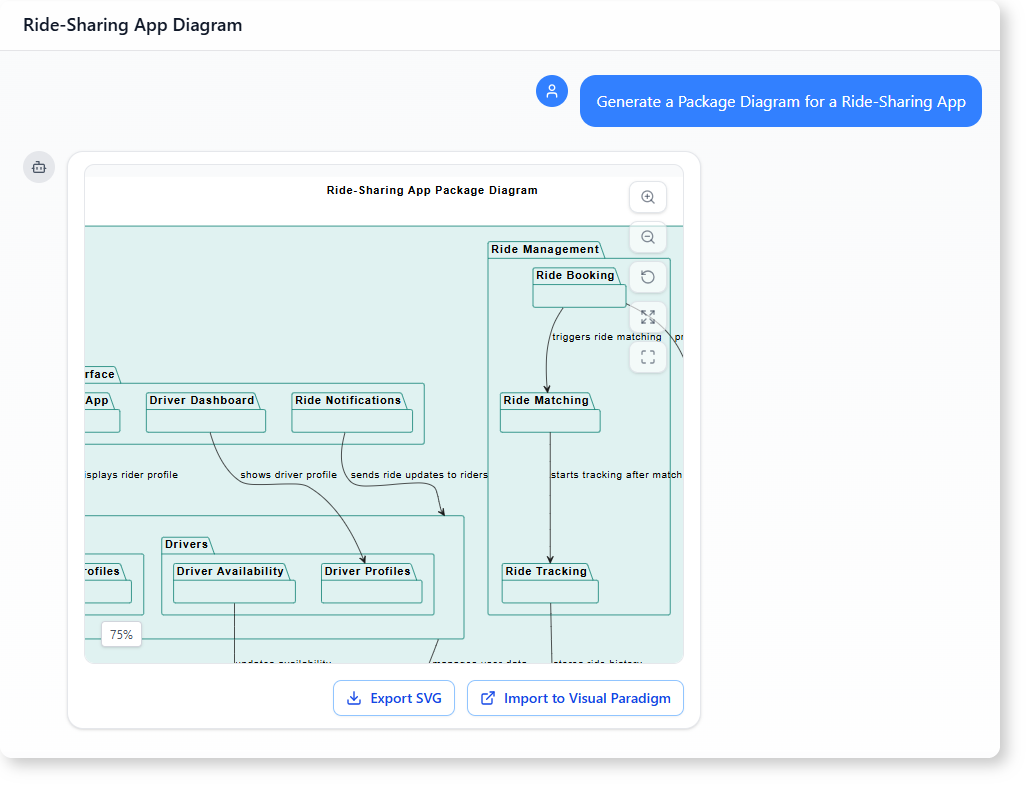Now Reading: How to Generate a Package Diagram for a Ride-Sharing App with AI-Powered Modeling
-
01
How to Generate a Package Diagram for a Ride-Sharing App with AI-Powered Modeling
How to Generate a Package Diagram for a Ride-Sharing App with AI-Powered Modeling
Why a Ride-Sharing App Needs a Clear Package Design
Building a ride-sharing app involves many moving parts: users, drivers, payments, tracking, and data storage. Without a clear structure, the software becomes chaotic. That’s where a package diagram comes in.
A package diagram helps visualize how different components of the app relate to one another. It shows which parts handle user profiles, manage rides, process payments, and store data. This clarity is essential for planning, development, and future system changes.
Instead of sketching this manually, a developer can now use AI-powered modeling software to generate a professional, accurate package diagram with just a simple prompt.

A Developer’s Journey to Build a Ride-Sharing App Package Design
The user is a software architect working on a new ride-sharing platform. Their team is still in the early design phase and needs to understand how to structure the system before writing any code.
They don’t want to spend hours creating a package diagram by hand. They also don’t want to rely on assumptions. So they turn to an AI-powered modeling tool.
They begin by typing:
Generate a Package Diagram for a Ride-Sharing App
The AI instantly produces a structured package diagram showing the main modules: User Management, Ride Management, Payment System, Database, and User Interface.
Each module is broken down further—like Rider Profiles, Driver Availability, Ride Booking, and Ride Tracking—so the team can see how different parts interact.
Next, they ask a follow-up question:
Summarize how this package design aligns with best practices in modular software design.
The AI responds with a clear breakdown, highlighting:
- Separation of concerns: Each module handles a distinct function.
- Clear data flow: Components like Ride Booking trigger matching, which then starts tracking.
- Independent management: Driver availability and user profiles are managed in separate, well-defined packages.
- Scalability: The design allows new features (like surge pricing or insurance) to be added without disrupting core processes.
This isn’t just a diagram—it’s a design guide built with real-world thinking.
Why This Is a Better Approach
Traditional package diagram tools require manual setup, syntax knowledge, or template use. They’re not intuitive and often produce incomplete or misaligned structures.
AI-powered modeling software changes that. It understands domain context—like ride-sharing—and generates a logical, scalable structure.
This is especially helpful when working with complex systems where:
- Components have overlapping responsibilities
- Data flows are not immediately obvious
- Teams need to align on system boundaries
The output isn’t just a visual—it’s a living design that reflects best practices in modular software design.
Benefits of Using AI for Package Diagrams
- Speed: No need to manually lay out packages or draw relationships.
- Accuracy: The AI builds a structure that reflects real-world system interactions.
- Clarity: The resulting diagram clearly shows how components work together.
- Alignment with best practices: The design naturally follows modular software design principles.
This is a powerful use case for AI-powered modeling software. It turns abstract system requirements into a clear, actionable design.
What Makes AI-Powered Modeling Software Different?
Most modeling tools are static. You input text or draw elements, and the output is fixed.
With AI-powered modeling software, the interaction is dynamic. The tool interprets your prompt and creates a relevant, context-aware diagram.
For a ride-sharing app, this means:
- The diagram includes key modules like user profiles, ride booking, and payment
- It shows how processes trigger each other (e.g., booking triggers ride matching)
- It highlights data movement and system dependencies
It’s not a magic wand. It’s an intelligent assistant that helps you think through the system before building it.
Is This the Best Package Diagram Tool?
Yes. When you need to design a ride-sharing app or any complex system, the best package diagram tool must:
- Understand real-world use cases
- Present a clear, scalable structure
- Reflect proven design principles
This AI-powered modeling software does exactly that. It doesn’t just generate a diagram—it helps build a solid foundation for software design.
Frequently Asked Questions
What is a package diagram and why is it useful?
A package diagram shows how different parts of a software system are grouped and interact. In a ride-sharing app, it helps define boundaries between user management, ride handling, and payment processing—making development more organized.
Can AI generate a package diagram for any system?
Yes. The AI understands system logic. Whether it’s a ride-sharing app, a ride-hailing platform, or a modular e-commerce system, it can generate a relevant package structure based on the prompt.
How does it align with modular software design?
The generated diagram naturally follows modular principles: each package manages a specific function, dependencies are clearly shown, and changes in one area don’t affect others unnecessarily.
Is this tool suitable for early-stage planning?
Absolutely. It’s ideal for architects and product owners who need to sketch out system boundaries before development begins.
Ready to map out your system’s interactions? Give our AI-powered modeling software a try at Visual Paradigm’s AI Chatbot today!.
